ECOPOWER SPORTS ®
HOW TO TREAT AN INJURED ANKLE

If you've ever injured your ankle, you know the importance of healing properly. But what if you're not sure how to heal properly? What can you do to make sure that the injury doesn't get worse? One common solution is to use ankle support. But what does that actually do for you? In this post, we'll take a closer look at what ankle support can help with and how they work. So whether you're recovering from ligament damage, an ankle sprain or just want some extra support, read on to learn more!
What does ankle support help with?
An ankle brace, also known as ankle support, ankle sleeve and foot support, among other names, is a device that helps to stabilise and protect the ankle joint prior to or post-injury. If you have injured your ankle, an ankle brace can help to speed up the healing process and reduce the likelihood of re-injury by providing support. There are many different types of foot braces available on the market, so it's important to do your research before purchasing one.
Will an ankle support help with foot pain?
There's no shortage of options when it comes to foot supports. ankle supports, plantar fasciitis inserts, weak ankle braces, heel pain kits... the list goes on. But all of them aim for the same thing, when worn, it should give your foot support.
But do any of these actually work? And more importantly, should you be wearing foot support?
Ankle & Foot supports
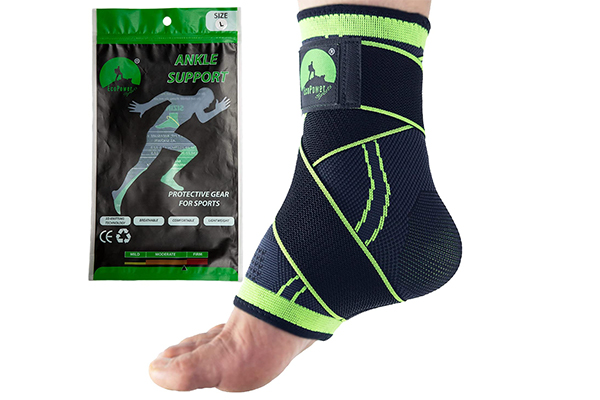
Are ankle supports any good?
There is some evidence that ankle supports can help with conditions like plantar fasciitis and Achilles tendonitis. However, the jury is still out on whether or not they're effective for general foot aching. If you have weak ankles or are prone to ankle injuries, ankle support may help to prevent future problems. However, if you're just dealing with occasional foot ache, a foot brace is unlikely to provide much relief.
In the end, it's up to you to decide whether or not an ankle sleeve is worth a try. If you're dealing with chronic pain or have a history of ankle injuries, it would definitely be worth giving one a shot. There are thousands of reviews on the internet from satisfied customers that declare how ankle supports help them manage the soreness related to plantar fasciitis, or that it boost their confidence when they wear a sports ankle support during a football match.
Should you wear an ankle support all day?
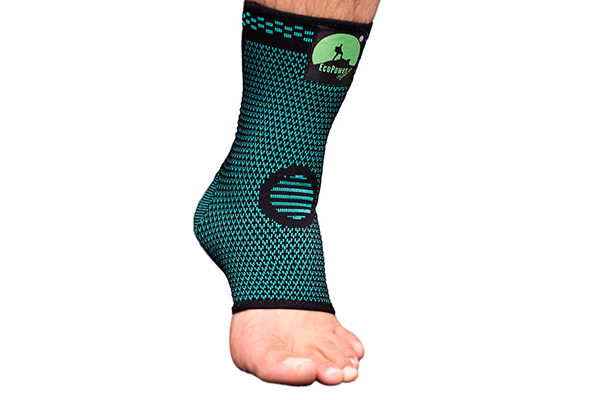
If you're struggling with ankle pain, you might be wondering if you should be wearing ankle support all day. The answer isn't necessarily clear-cut, but there are a few things you should keep in mind. First, ankle supports can help reduce aching and inflammation associated with conditions like plantar fasciitis and weak ankles. They can also help improve blood circulation, reduce swelling, and ease foot pain while providing more support. However, it's important to not have them on too tightly or for too long, as this can actually have the opposite effect. It could reduce blood flow. Additionally, it's generally considered safer not to use ankle supports overnight for the same reason. So if you're trying to decide whether or not to make use of your ankle support all day, just consider how tight is your ankle support, and if it causes discomfort, change it.
Does an ankle brace help the foot?
Foot supports are devices that are worn around the ankles to provide the right support and stability to the joint. The use of an ankle sleeve can reduce soreness and reduce swelling in the joint, and can also be used to prevent further injury. There are a variety of different ankle sleeves available on the market, designed to meet the needs of different individuals.
Some common conditions that may benefit from the use of ankle supports include arthritic joints plantar fasciitis, arthritis, and instability in the joint. For those who have suffered a recent injury, an ankle sleeve sock can provide additional support during the healing process. Wearing ankle support is often recommended by medical professionals as part of a comprehensive care plan. Depending on the design of the support, there are some potential drawbacks to wearing it, such as reduced range of motion, but the benefits typically outweigh the risks.
Ankle Sprain

A sprained ankle is one of the most common injuries, and usually happens when you twist or turn your ankle in an awkward direction. This can stretch or tear the ankle ligaments, which are responsible for holding the ankle bones together and providing stability. Unless you're a professional athlete, there's a good chance that you'll experience a sprained ankle at some point in your life. But don't worry – there are ways to protect yourself and reduce the suffering if it does happen. Wearing an ankle brace can help to stabilise the ankle joint while providing firm support. This can minimise the risk of further injury and help to reduce pain and reduce swelling . So if you're worried about twisting your ankle, make sure to wear an ankle brace for protection.

The severity of each ankle sprain will depend on the damage caused and the stability of the joints after the incident has occurred.
It is likely to be a sprain or strain if:
-
1. It is likely to be a sprain or strain if you have discomfort, tenderness or weakness in your ankle, foot, wrist, thumb, knee, leg or back.
-
2. Restriction of movement is common with ankle sprains and strains.
-
3. The injured area is often swollen or bruised with sprains and strains.
-
4. You may find it difficult to put weight on the injury or use it normally with sprains and strains.
-
5. Muscle spasms or cramping can occur with sprains and strains.
Can I keep on walking on a sprained ankle?
You're out for a walk, enjoying the fresh air and the scenery when you suddenly misstep and twist your ankle. The pain is sharp, and you know you've done some damage. But can you keep on walking? Is it safe?

There are risks and benefits to consider. On the one hand, walking on a sprained ankle can help to reduce swelling and improve the range of motion. However, it's also possible to aggravate the injury, delaying healing and increasing the risk of further injuries. Wearing ankle support can help to reduce these risks by providing additional stability to the ankle joint as a result it also ease aching in the ankle and foot joints. Additionally, velcro straps are comfortable fit and can be quickly and easily adjusted providing excellent support, just the right amount of support you need, reducing the risk of re-injury.
So, what's the verdict? If you have a mild sprain, keeping on walking may be beneficial. However, it's always best to err on the side of caution and consult with a doctor or physical therapist before making any decisions. And if you do decide to walk, be sure to wear ankle support and take things slowly at first.
What does a torn ligament in ankle feel like
1. Pain
-
One of the most common signs of a torn ligament is pain. The pain may be sudden and severe, or it may come on gradually. If you suspect that you have a torn ligament, it’s important to see a doctor or other medical professional as soon as possible so that you can get the care you need.
2. Swelling
-
Another common sign of a torn ligament is swelling. This can occur shortly after the injury or may develop over time. If you notice that your foot is swollen, especially if it is accompanied by soreness, it’s important to see a doctor so that you can get the attention you need.
3. Bruising
-
Bruising is another common sign of a torn ligament. The bruising may occur immediately after the contusion or may develop over time. If you notice bruising on your foot, especially if it’s accompanied by pain or swelling, it’s important to see a doctor so that you can get the treatment you need.
4. Difficulty Walking
-
If you have a torn ligament in your foot, you may have difficulty walking. This can be due to ache, swelling, or both. If you find that you’re having difficulty walking, it’s important to see a doctor so that you can get the treatment you need.
5. Locking or Popping Sensation
-
A torn ligament in your foot may also cause a locking or popping sensation. This can be due to the injury itself or to swelling that develops after the lesion. If you experience a locking or popping sensation in your foot, it’s important to see a doctor so that you can get the treatment you need
Foot Ligament Damage

When you hear the word "ligament," you might think of a grade 1 sprain that will have you feeling better in a week or two. But ligaments come in different grades, just like most things in life. A grade 2 ligament tear is more severe, and a grade 3 tear is the worst. While a grade-1 tear may only require some ice, as it is a partial tear of the ligament, and usually heal without surgery. A grade-2 tear is a complete tear of the ligament and may require surgery. A grade-3 tear is a complete tear of the ligament with dislocation of the ankle joint and requires surgery.
Ligament tears can happen anywhere in the body, but they're especially common in the foot. That's because the foot has so many moving parts, and all of those parts are supported by ligaments. When one of those ligaments is torn, it can be very painful.
The best way to treat a torn ligament is to get the right support. That might mean wearing a brace or using crutches. It might also mean getting surgery to repair the damage. Whatever the treatment, it's important to follow your doctor's instructions and give yourself time to heal. Otherwise, you could end up with a long-term injury.
There are different levels of an ankle injury, so each case should be treated individually, and not in a generalising manner.
Torn ligament in foot recovery time
We are always looking for a magical solution to our problems, especially if the problem is connected to the feeling of pain and restriction of movement. But as you expect, there is not a magical potion. Your recovery time will depend on the grade of your ligament lesion, as well as your age, overall health, and diet.
There are four main ligaments in the foot that can be sprained or torn: the anterior talofibular (ATFL), the calcaneofibular (CFL), the posterior talofibular (PTFL), and the spring (or summer) ligament. All of these ligaments attach to the ankle, and provide support and stability to the ankle articulation.
The right type of support is essential for healing ligament damage. For grade 1 and 2 tears, an immobilisation boot or lightweight design brace is typically recommended for 6-8 weeks. For grade 3 tears, surgery is usually required to repair the ligament, followed by immobilisation in a boot or brace for 8-12 weeks. Physical therapy may also be recommended to help stretch and strengthen the surrounding muscles and tissues.
GRADE 1
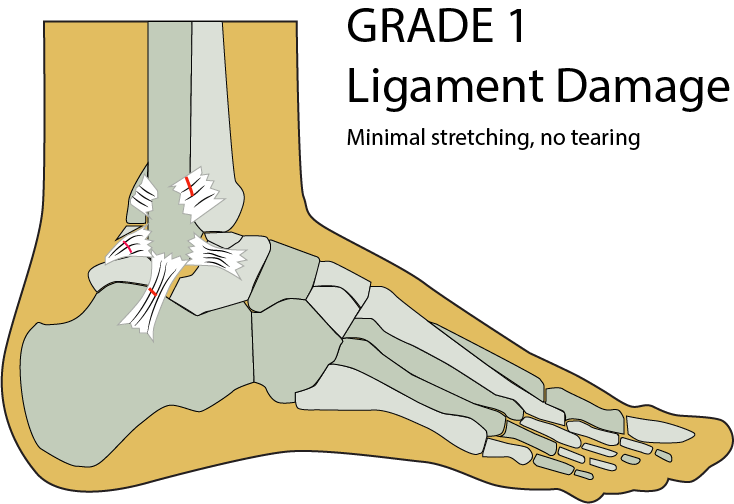
-
SEVERITY: Grade 1
-
DAMAGE TO THE LIGAMENTS: Minimal stretching, no tearing
-
SYMPTOMS: Mild pain, start to swell, and tenderness. Usually no bruising. No joint instability. No difficulty bearing weight
-
RECOVERY TIME: 1–3 weeks
GRADE 2
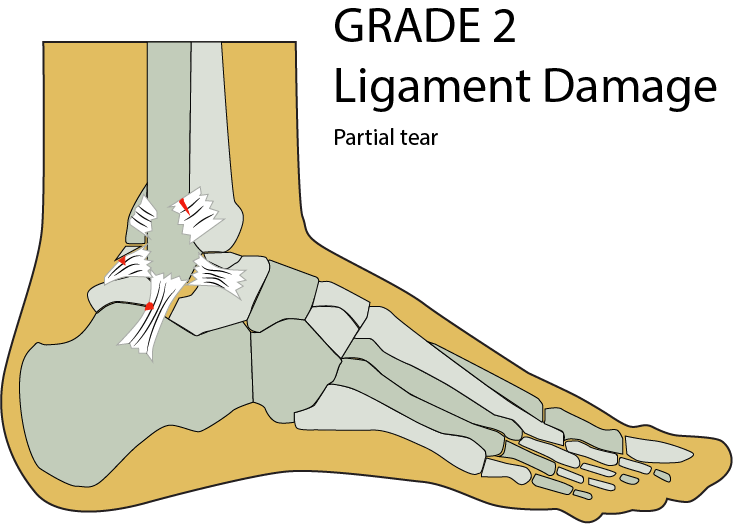
-
SEVERITY: Grade 2
-
DAMAGE TO THE LIGAMENTS: Partial tear
-
SYMPTOMS: Moderate pain, start to swell, and tenderness. Possible bruising. Mild to moderate joint instability. Some loss of range of motion and function. Pain with weight-bearing and walking
-
RECOVERY TIME: 4–8 weeks
GRADE 3
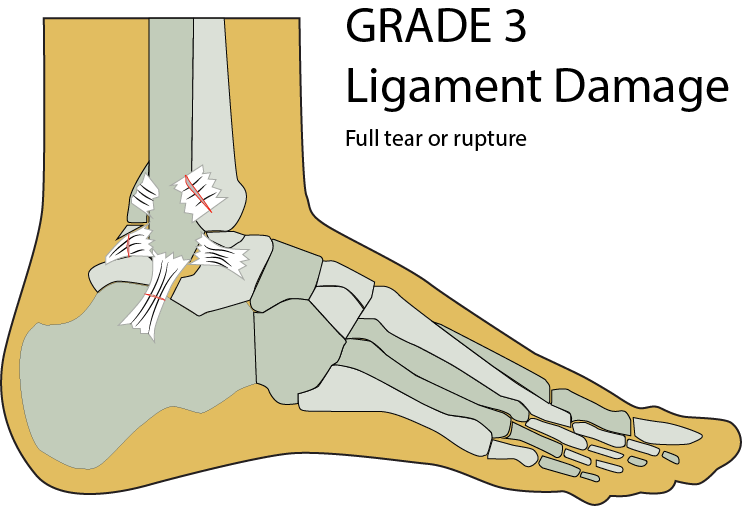
-
SEVERITY: Grade 3
-
DAMAGE TO THE LIGAMENTS: Full tear or rupture
-
SYMPTOMS: Severe pain, start to swell, tenderness, and bruising. Considerable instability and loss of function and range of motion. Unable to bear weight or walk
-
RECOVERY TIME: Several months
How to recover fast from an ankle injury?
The RICE method is a time-honoured treatment for a variety of ankle injuries, from heel pain to plantar fasciitis to Achilles tendonitis. The key components of the RICE method are rest, ice, compression, and elevation. While rest and ice are self-explanatory, compression and elevation can be a bit more complicated. compression involves using firm support, like an ankle brace, to stabilise the injury and prevent further swell. elevation involves keeping the injured ankle raised above the level of the heart to reduce swelling. When used together, the RICE method can help you recover from your ankle injury more quickly.
RICE METHOD
-
Rest – for the next two to three days, you may need support to move around such as crutches.
-
Ice – wrap ice or a bag of frozen peas in a cloth and apply it to your ankle regularly (every 20 minutes) for the first two to three days. (don't stick your ankle into a bucket of ice as it hurts and could damage your skin).
-
Compression – For compression, find an ankle brace made of stretch material. Such as ECOPOWER SPORTS Ankle Brace Support.
-
Elevate – when sitting or lying down, raise your ankle above the level of your heart.
Conclusion
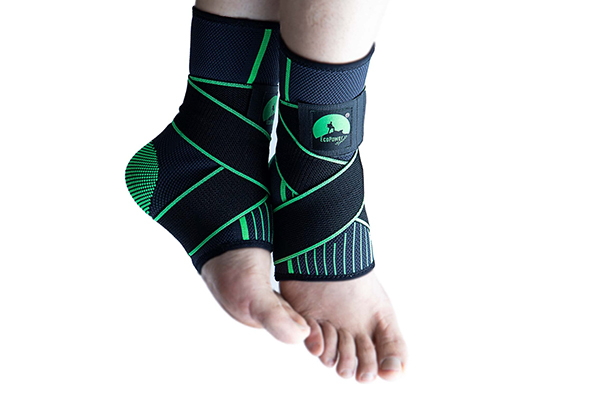
If you are recovering from an ankle injury, take your time. Returning to your normal routine too quickly can lead to another injury and set you back even further. Let your ankle heal fully before returning to activities like running or playing football. If you’re finding it difficult to stay inactive, our team can help get you back on track with the right ankle brace that will give you more support and protect your articulations as it heals. As explained in this article supports and braces provide many benefits. Be patient, the ligaments will get stronger over time, and in no time you’ll be back to being active and pain-free.
Take the time to find a support that better fit your needs. This premise works for any support, whether it will be won on your leg, ankle or any body part.
We really hope this article was useful and helped you in any form. Please leave a comment, telling us about your own experience with ankle supports, was it positive? did it work for you? did it give your foot more support?
we would love to hear your story.
Be on the lookout for our upcoming blog post about how to select ankle supports with enhanced comfort while still, being the ideal support for plantar fasciitis – until then stay active and healthy!
No content on this site, regardless of date, should ever be used as a substitute for direct medical advice from your doctor or other qualified clinician.
Joel Bernardes

